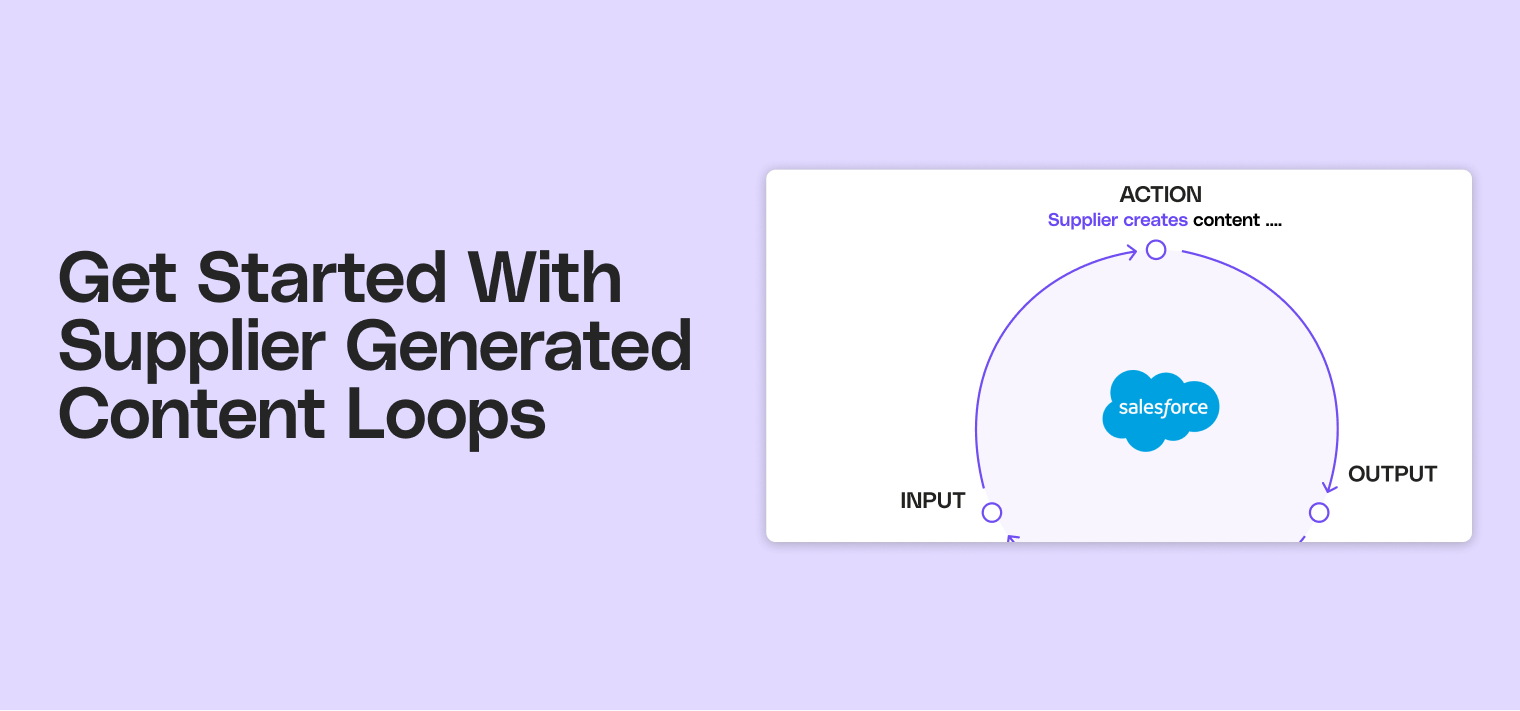For businesses wishing to thrive in the digital era, content is king. It plays a crucial role in driving customer engagement, brand awareness, and ultimately, business growth.
While companies have traditionally shouldered the responsibility of creating content, an emerging trend is changing the landscape - supplier-generated content loops. This guide will explore this rising trend, from understanding its importance to implementing and optimizing it for future success.
| Key Element | Description | Tips for Optimization |
|---|---|---|
| Definition and Importance | Supplier-generated content loops involve suppliers in a company's content creation, enhancing content marketing efforts. | Leverage suppliers' expertise and industry insights to create more comprehensive and engaging content. |
| Role of Suppliers | Suppliers provide unique perspectives, emerging trends, case studies, and expert opinions. | Actively involve suppliers to tap into their specialized knowledge and experiences. |
| Incentives for Suppliers | Suppliers are motivated by intrinsic, extrinsic, and social incentives. | Offer a mix of incentives to encourage suppliers to contribute high-quality content. |
| Building Content Loops | Involves identifying the right suppliers, setting expectations, and ensuring quality control. | Establish clear communication, provide guidelines, and implement a robust review process. |
| Case Studies | Examples of JustGiving and Salesforce utilizing supplier-generated content loops. | Analyze successful implementations to understand best practices and potential challenges. |
| Future Trends | Emerging trends include AI and machine learning for content creation. | Stay ahead by adopting new technologies and training suppliers on the latest tools. |
Understanding supplier-generated content loops
Supplier-generated content loops refer to a collaborative approach where suppliers actively contribute to content creation for a company.
This two-way relationship fosters a mutually beneficial environment, allowing suppliers to showcase their expertise and the company to benefit from fresh, diverse perspectives.
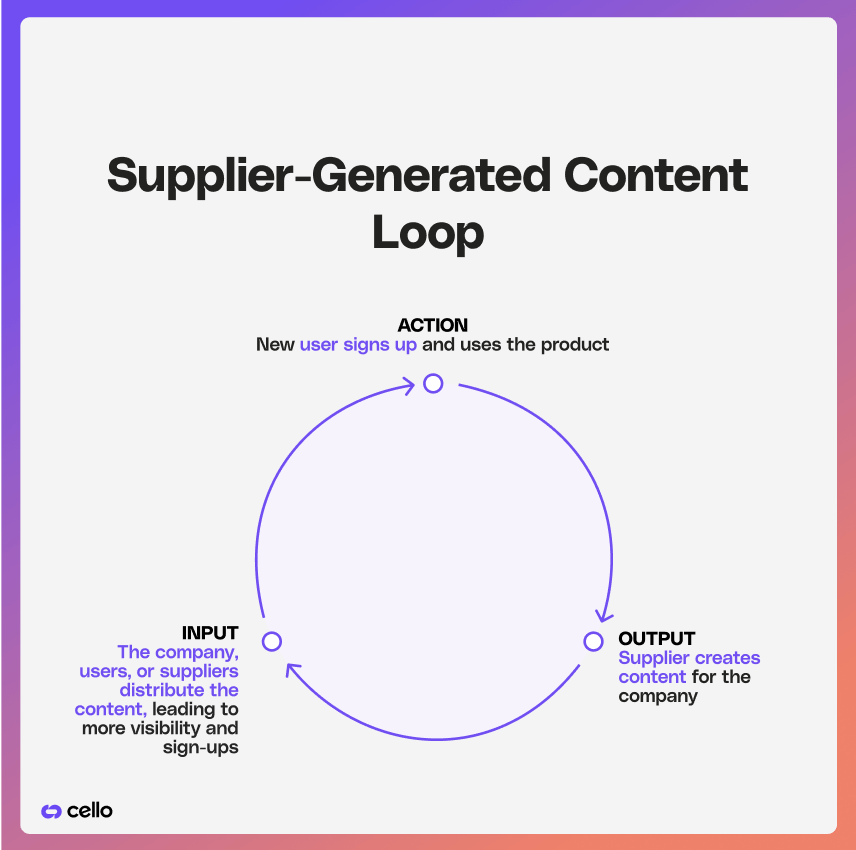
Definition and importance of supplier-generated content loops
📖🔁 A supplier-generated content loop is a systematic process that occurs when suppliers are involved in a company's content creation, amplifying a company's content marketing efforts.
By leveraging the expertise and industry insights of suppliers, companies can deliver more comprehensive, relevant, and engaging content to their target audience.
This collaborative approach enriches the content and strengthens the relationship between the company and its suppliers. But what exactly makes supplier-generated content loops so important?
Supplier-generated content loops contribute to a more authentic and credible brand image, improving thought leadership. When suppliers actively participate in content creation, it adds a layer of authority and expertise to the content, building trust among the audience.
Imagine reading a blog post that not only provides valuable information but also includes insights from industry experts who have hands-on experience. It instantly elevates the content and makes it more trustworthy, establishing the company as a reliable source of information and giving the company a competitive edge.
The role of suppliers in content creation
Suppliers, as industry experts, possess specialized knowledge and experiences that can greatly enrich content creation. By actively involving suppliers in the process, companies can tap into this valuable resource and gain access to unique perspectives that may have been overlooked otherwise.
But what exactly is the role of suppliers in content creation?
- Firstly, suppliers can provide insights into emerging trends. As they work closely with various companies and clients, suppliers can identify emerging trends, technological advancements, and changing consumer preferences. When this is included in content pieces, companies' audiences are more up to date, allowing firms to position themselves as industry leaders.
- Furthermore, suppliers can share case studies and success stories. These real-life examples add credibility to the content and provide practical insights and solutions to common challenges. Suppliers can therefore inspire and educate the audience, making the content more relatable and actionable.
- Lastly, suppliers can offer expert opinions. Their deep understanding of the industry allows them to provide valuable perspectives on various topics. Whether it's analyzing market trends, discussing the impact of new regulations, or sharing predictions for the future, suppliers can contribute thought-provoking insights that stimulate discussion and engage the audience.
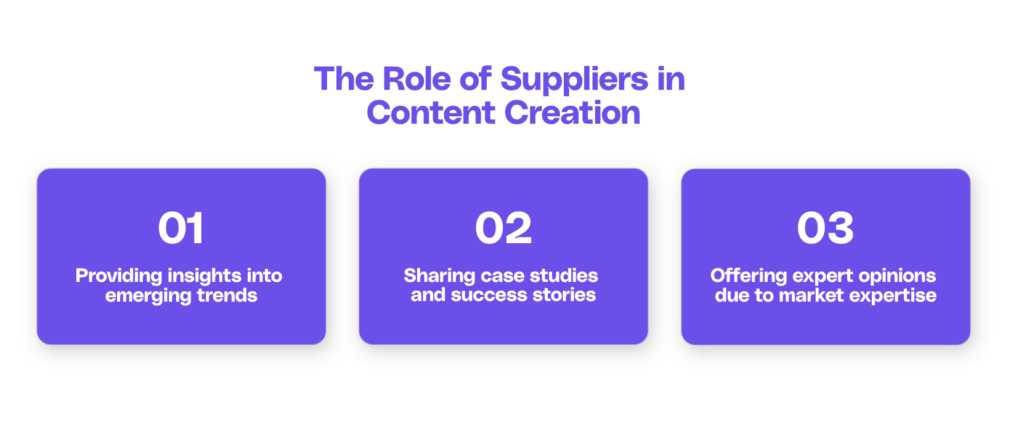
Value generation and distribution
Suppliers are the value generators for supply-generated content loops. They are the party responsible for creating the content pieces, and they are driven by any of the following criteria:
- Intrinsic Incentives: This involves creating content for personal utility, including feelings of accomplishment, alignment with the company's values, and wanting to have articles released on different platforms
- Extrinsic Incentives: This occurs when suppliers create content pieces for monetary reasons, such as cash payments, discounts on a company's products, or early access to features.
- Social Incentives: This is the case when suppliers create content for social gain, including recognition, status, or social awards. Having an article published on a famous company's website, for instance, can greatly boost a supplier's credibility.
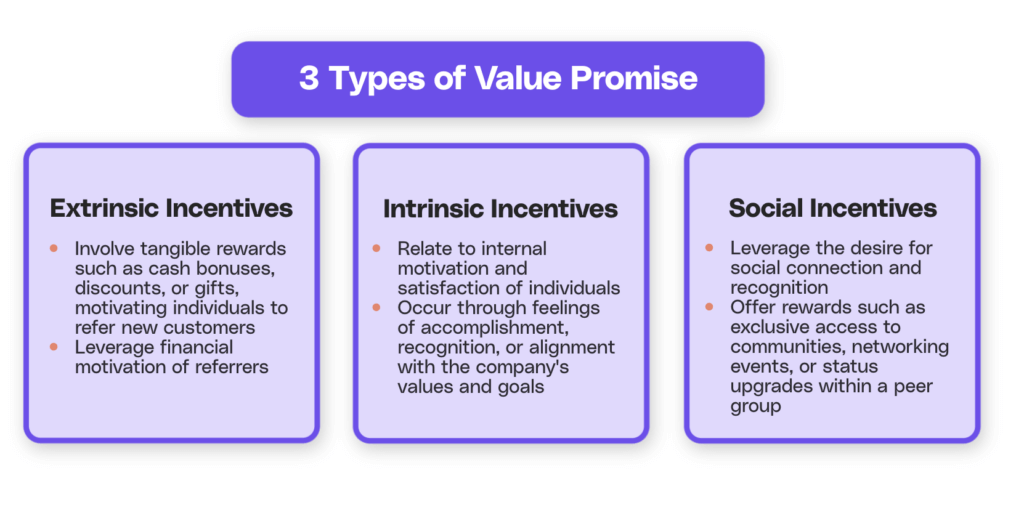
On the other hand, value distributors could be the company, users, or supply itself. They are the ones responsible for sharing content, and the motivations are the same ones as above.
In conclusion, supplier-generated content loops play a crucial role in content marketing strategies. By involving suppliers in content creation, companies can tap into a wealth of knowledge and expertise, delivering more valuable and impactful content to their audience, while improving their brand image.
Characteristics of suppliers
There is a large variety of suppliers on the market. There are three key criteria you should be looking for:
- End users: Suppliers should target the same end users as you, to ensure that their content pieces are relevant and overlapping with what your company does.
- Replaceability: Suppliers should be replaceable, i.e. there should be a lot of them, with similar skillsets, and with each one generating just a small percentage of your company's content value. Think of this as diversification - the more suppliers you have, the more diverse and unique your content will be, and the less you will be reliant on a single supplier's output.
- On platform: Suppliers should also be generating and distributing the value on your company's platform, rather than exclusively on their own (or other) platforms. Supplier-generated content loops tend to work best for marketplaces, where users use a company's service and are then likely to become suppliers/sellers themselves.
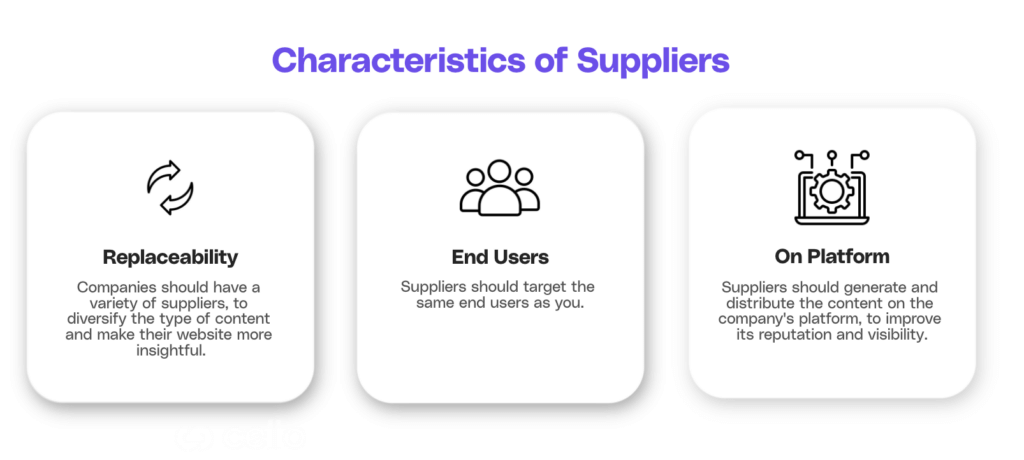
On average, supplier-generated content loops have lower creation costs than company-generated content loops, as most of the value generation is outsourced to suppliers. This, of course, rests on the assumption that there is sufficient distribution and liquidation to incentivize suppliers.
Even once the loop has started, it tends to accelerate quickly, as the money, people and time costs do not lie with the company. The only growth loops faster than this are user-generated content ones.
Case study: JustGiving
JustGiving is a popular fundraising platform. Individuals can publish campaigns to raise funds, primarily for charity and community-improvement motivations. When someone posts a campaign, they can add a few details and tell viewers their story, and donating to them is a simple process.
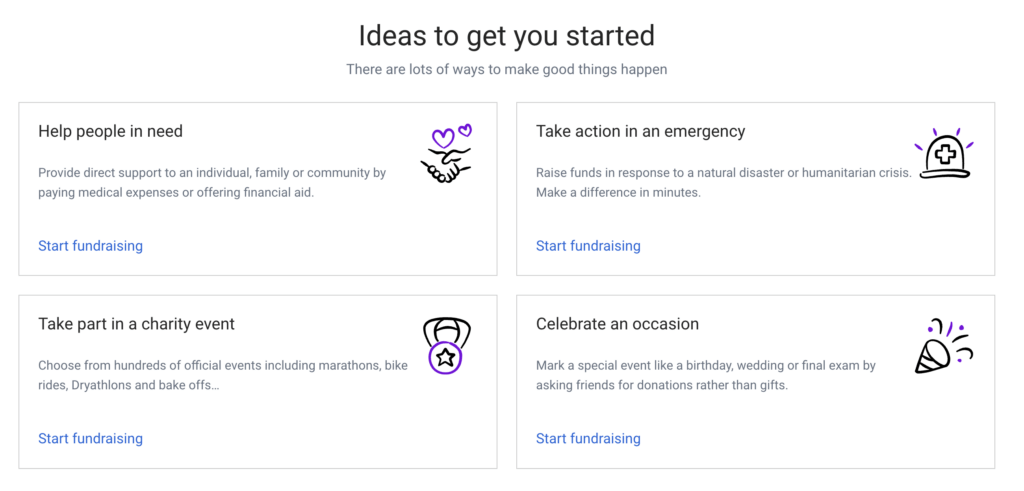
As viewers become donors, a certain share of these eventually become campaign fundraisers themselves. When this occurs, they publish another campaign, generating more views and more donations, re-initiating the loop.
As we had analyzed above, the value generator in this case is the supply side of the marketplace, as individuals fundraising are responsible for the majority of the content. In such instances, they are driven by extrinsic incentives, namely receiving donations. Similarly, financial incentives motivate the value distribution by suppliers.

Case study: Salesforce
Salesforce is a leading CRM software, and it too benefits from supplier-generated content loops. When visiting its website, we can observe that it is full of resources, blogs, and articles, aiming to educate users, but also increase traffic and conversions.
While a substantial part of the content is written by Salesforce employees, the company also partners with suppliers to generate such articles. This primarily involves partnerships with guest writers, who Salesforce invites to write articles on industry-related topics.
By partnering with external writers, Salesforce can drastically increase the number of articles it releases, while also tapping into the writers' audiences. Moreover, the suppliers (who are also the value generators), benefit from writing and sharing the content, as it allows them to reach Salesforce's vast user base.
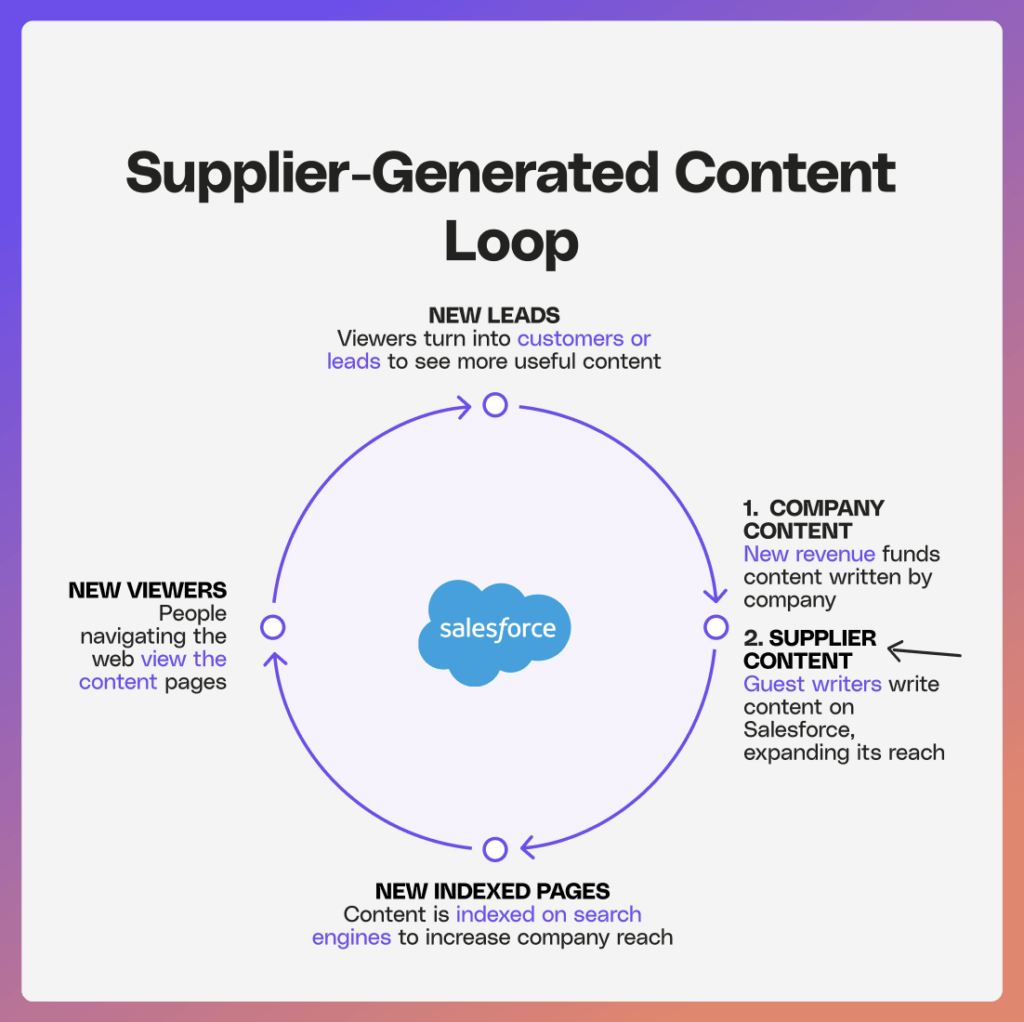
Building a successful supplier-generated content loop
Building an effective supplier-generated content loop requires careful planning and execution. Here are two key steps to kickstart the process.
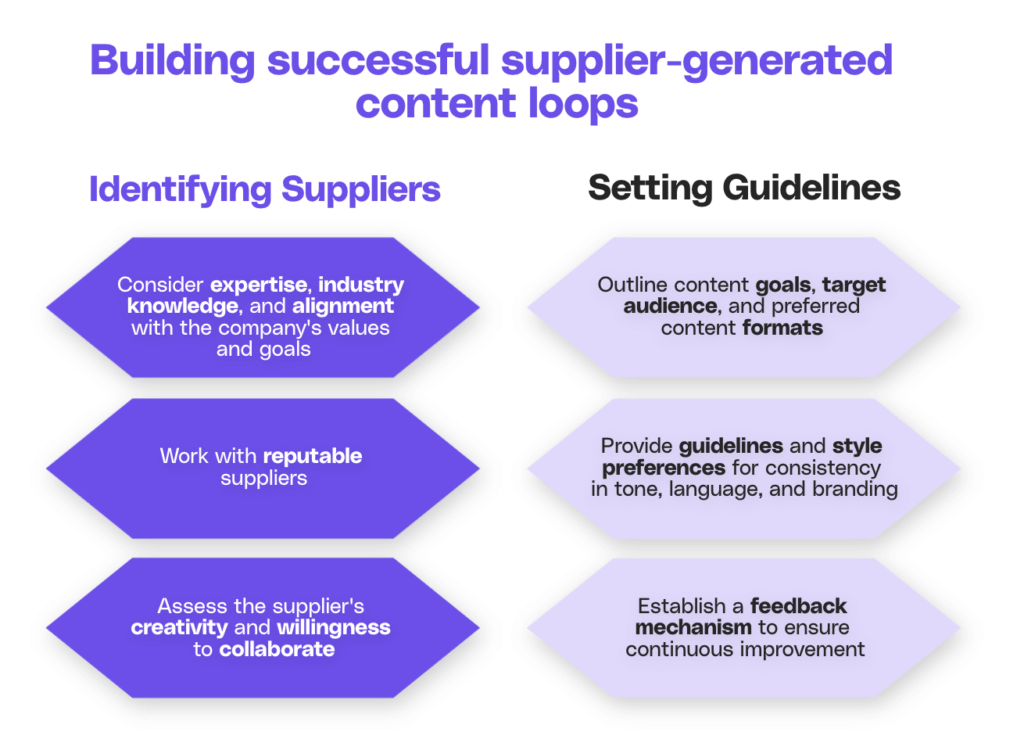
Identifying the right suppliers for content generation
When selecting suppliers to participate in the content creation process, it is crucial to consider their expertise, industry knowledge, and alignment with the company's values and goals.
Suppliers who have a track record of delivering quality products or services and have a strong presence in the industry are often ideal candidates. By aligning with reputable suppliers, companies can tap into their expertise to create high-quality content that resonates with the audience.
Furthermore, beyond just reputation and industry standing, companies should also assess the supplier's creativity and willingness to collaborate. Suppliers who are open to brainstorming sessions and feedback tend to contribute more innovative and engaging content.
This collaborative approach fosters a sense of partnership between the company and the supplier, leading to a more fruitful content creation process.
Setting expectations and guidelines for content creation
Clear communication and expectations are paramount to the success of supplier-generated content loops. Companies should outline their content goals, target audience, and preferred content formats to suppliers.
Additionally, providing guidelines and style preferences ensures consistency in tone, language, and branding across all content pieces. Collaborative tools and regular check-ins can facilitate effective collaboration and streamline the content creation process.
Moreover, in setting expectations, companies should also establish a feedback mechanism to ensure continuous improvement in the content generated. Constructive feedback not only helps suppliers understand the company's preferences better but also encourages them to refine their content creation skills.
This iterative process of feedback and improvement can lead to a more refined and impactful content output that resonates with the target audience.
Implementing supplier-generated content loops
Implementing a Supplier-Generated Content Loop involves a series of steps to integrate suppliers into the content creation process. Here are some key steps to consider.
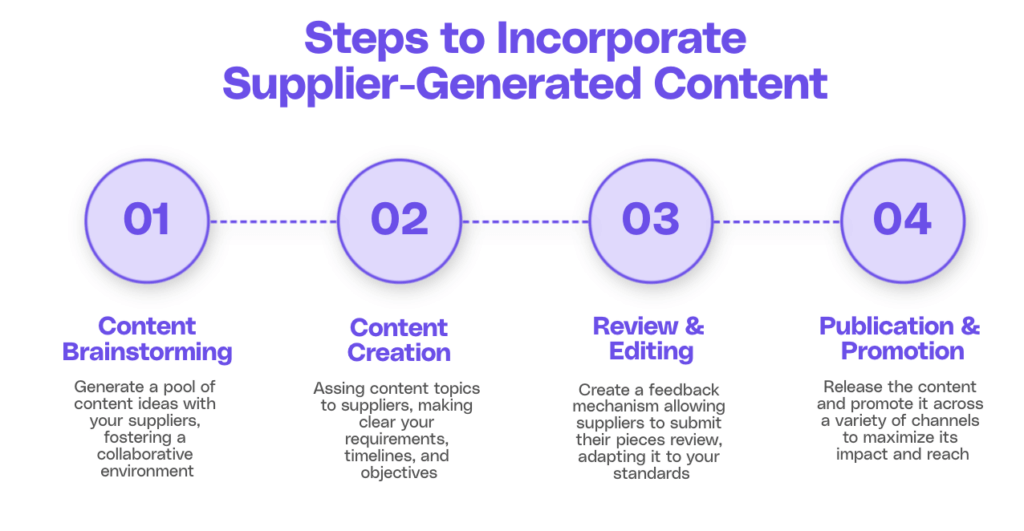
Steps to incorporate supplier-generated content
- Content Brainstorming: Collaborate with suppliers to generate a pool of content ideas that align with the company's goals and resonate with the target audience. Fostering a collaborative environment here is crucial, e.g. by having joint brainstorming sessions with suppliers.
- Content Creation: Assign content topics to suppliers, ensuring they have a clear understanding of the content requirements and objectives.
- Content Review and Editing: Establish a robust feedback loop where suppliers can submit their content for review and revisions to ensure alignment with the company's standards and messaging.
- Content Publication and Promotion: Once the content is finalized, promote it through various channels, such as social media, email newsletters, and industry forums, to maximize its reach and impact.
Case study: Airbnb
Let's look at an example for this, Airbnb. Airbnb is a leading holiday rental platform, and thrives on supplier-generated content loops. Suppliers are in this case users who offer their homes as rental properties on the platform.
As regular users rent on Airbnb, a share of these will turn into rental suppliers themselves, creating content about their properties. The suppliers then list this content on the platform, and share it, in order to increase their rental revenues.
The loop then repeats itself, with a share of renters once more turning into suppliers. Suppliers are once more the value generators, offering their properties (and in particular, content about their properties) for extrinsic, financial incentives.
Recently, Airbnb has actively been following the steps listed above to explore with new business areas and supplier-generated content loops. Let's explore these one by one:
- Content Brainstorming: After years or exclusively supplying rental properties, Airbnb has expanded into more unique experiences and activities. To do so, they have collaborated with a number of suppliers across the world, identifying the most attractive offerings. As Airbnb's target audience are travelers and thrill-seekers, this new product vertical seems promising.
- Content Creation: After selecting the most interesting experiences (and these keep increasing, day-by-day), Airbnb assigns content creation to its suppliers. This involves creating a clear and attractive value proposition of whatever activity or rental property suppliers are offering, which can then be displayed on Airbnb to initiate supplier-generated content loops.
- Content Review and Editing: While the precise content review protocols are not publicly available, Airbnb likely examines the content provided by suppliers, ensuring it appropriately conveys the value proposition and has potential to go viral.
- Content Publication and Promotion: Once the content is ready, Airbnb releases it on its platform and promotes it through a variety of channels. The most prominent channel is its homepage, as users are immediately exposed to it when opening the website and are thus more likely to be intrigued by the content displayed there.
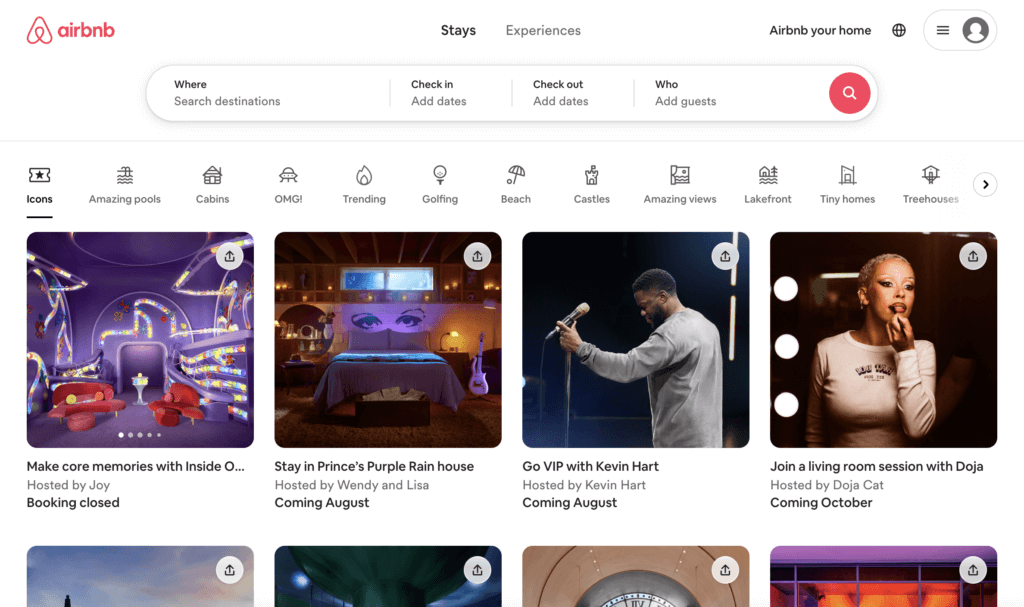
Overcoming common challenges in implementation
While supplier-generated content loops offer significant advantages, they may present challenges. Companies should be aware of and address these challenges to ensure a smooth implementation.
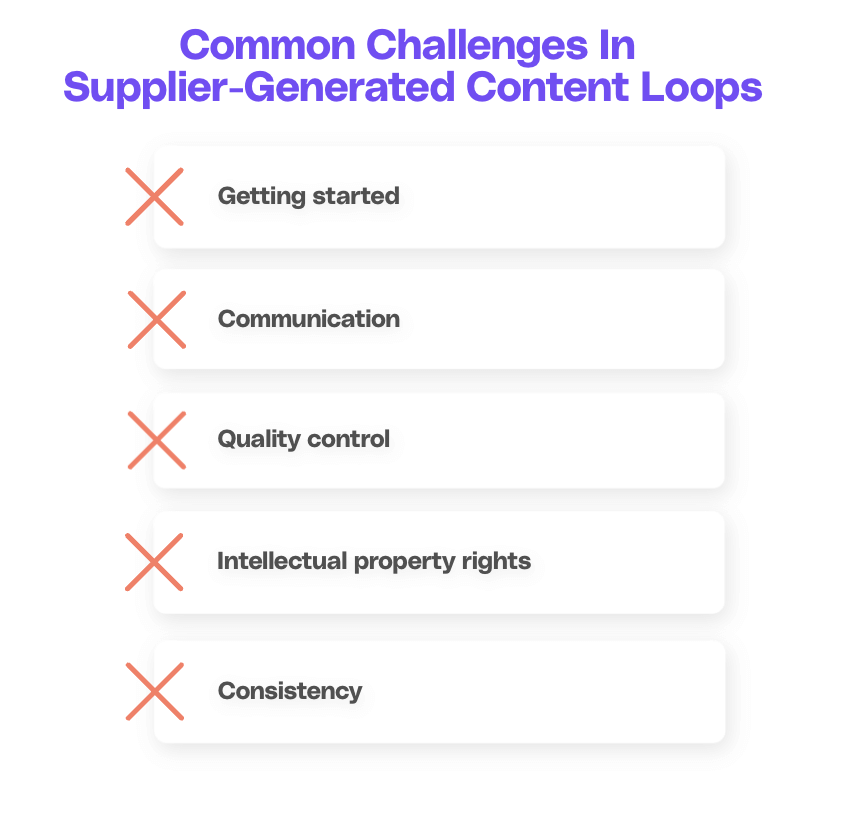
- Getting started: Company-generated content loops are usually a prerequisite for supplier-generated ones, as the firm must have enough visibility and liquidation to motivate suppliers to generate and distribute content.
- Communication: Establish clear communication channels and expectations to minimize miscommunication and ensure timely collaboration.
- Quality Control: Implement a robust review and editing process to maintain consistent quality standards across all content pieces.
- Intellectual Property Rights: Define ownership and usage rights to avoid any legal conflicts regarding content ownership.
- Consistency: Maintain consistent branding and messaging, while still leveraging different perspectives to enhance the content.
Distribution constraints
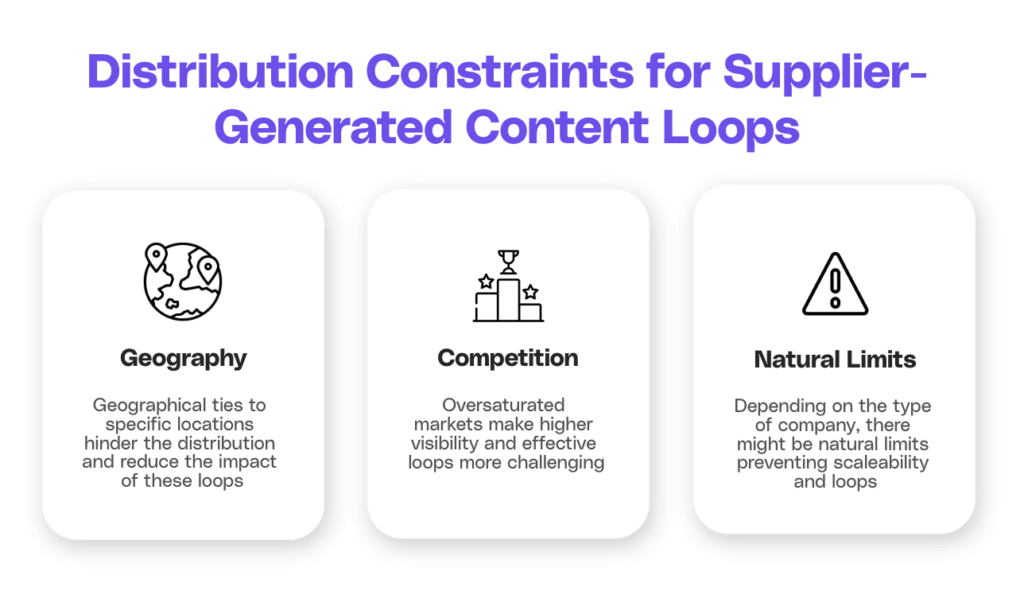
Besides the aforementioned implementation challenges, there are some more specific challenges related to supplier-generated content distribution.
These include:
- Geography: If a company is geographically tied to a location, it will be difficult and pointless to expand to other regions.
- Competition: Distributing content in an oversaturated market is challenging. Search engines are already crowded with content, and even the best suppliers may not lead to higher ranking in search results.
- Natural limits: Some platforms have a limit to how many people can supply or distribute content.
Optimizing supplier-generated content loops
Optimizing Supplier-Generated Content Loops involves continuous improvement and analysis to enhance content quality and achieve better results. Here are two key strategies to optimize the content loop:
Regular review and feedback for improvement
Establish a feedback loop with suppliers to provide regular updates on content performance and audience engagement.
This feedback loop serves as a valuable learning tool for suppliers, enabling them to refine their content creation skills and align their efforts with the company's objectives. Additionally, feedback allows for ongoing improvements and adjustments to the content strategy.
By promoting a culture of open communication and collaboration with suppliers, companies can cultivate strong partnerships and relationships that drive mutual success. It is crucial to create a space for constructive dialogue, where ideas can be shared, challenges addressed, and successes celebrated.
Leveraging analytics for content loop optimization
Analyzing content performance metrics, such as views, engagement rates, and conversions, provides valuable insights into what content resonates best with the target audience.
Companies can leverage these analytics to identify trends, strengths, and weaknesses, and optimize the content loop accordingly. This data-driven approach ensures that the content remains relevant, compelling, and effective in driving audience engagement and conversions.
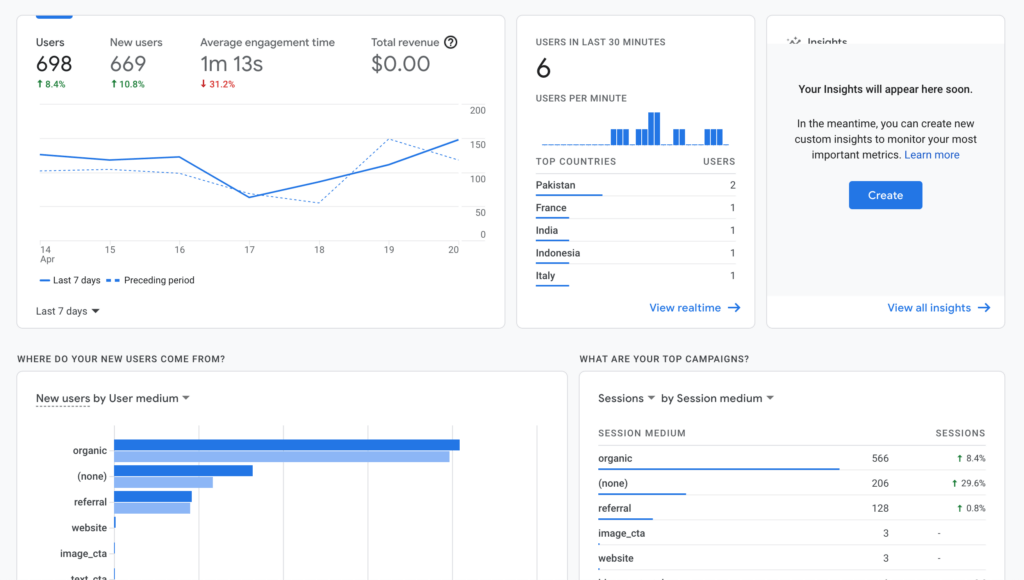
Furthermore, the use of advanced analytics tools and technologies can offer deeper insights into consumer behavior and preferences, allowing companies to tailor their content strategies with precision.
By leveraging the power of data analytics, businesses can gain a competitive edge in understanding market trends, predicting consumer needs, and adapting their content loop strategies to stay ahead of the curve. This maximizes the impact of supplier-generated content and positions the company as a forward-thinking industry leader in content optimization.
Future of supplier-generated content loops
The future of supplier-generated content loops holds great promise as technology evolves and consumer expectations change. Here are two emerging trends in this space:
Emerging trends in supplier-generated content
As AI and machine learning technologies continue to advance, suppliers may leverage these tools to automate parts of the content creation process.
Natural language processing algorithms can assist in generating drafts, while data analytics can provide insights into audience preferences, enabling suppliers to create more personalized content.

One exciting aspect of this trend is the potential for suppliers to collaborate with AI-powered content creation platforms. These platforms can analyze vast amounts of data and generate content that aligns with a brand's voice and style.
Preparing for the future of supplier-generated content loops
Companies should be proactive in staying ahead of the curve by embracing innovative tools, technologies, and methodologies. By exploring and adopting emerging trends, companies can strengthen their supplier-generated content loops. Two strategies they can use are:
- Investing in training and upskilling their suppliers: As technology advances, it is crucial for suppliers to stay updated with the latest tools and techniques. By providing training programs and resources, companies can empower their suppliers to create even more impactful and engaging content.
- Building strong relationships with their suppliers: Collaboration and open communication are key to successful supplier-generated content loops, as they help companies ensure that suppliers feel valued and motivated to contribute their expertise and perspectives.
In conclusion, supplier-generated content loops offer companies an opportunity to enhance their content marketing efforts by tapping into the expertise and perspectives of their suppliers.
By understanding the importance of these loops, building effective collaboration, implementing robust processes, optimizing content strategies, and preparing for the future, companies can unlock the full potential of supplier-generated content loops and drive engagement, brand awareness, and business growth.
Unlock the power of peer-to-peer referrals with Cello
As you embrace the potential of supplier-generated content loops to amplify your content marketing, consider the next step in harnessing user-driven growth: Cello. With Cello, you can transform your users into a powerful growth channel, just as you've leveraged supplier expertise for content. Cello's seamless integration and automated rewards system make it the perfect addition to any SaaS product, offering a peer-to-peer referral program that's as easy to implement as it is effective. Experience the viral growth and watch your conversion rates soar. Ready to see how Cello can revolutionize your growth strategy? Book a demo today and join the ranks of companies like tl;dv, who have seen remarkable success with our user referral program.
Resources
Related Articles

Complete Guide to your Affiliate Program for B2B SaaS
Learn how to get started with affiliate referral programs for B2B SaaS. Understand if affiliate ...
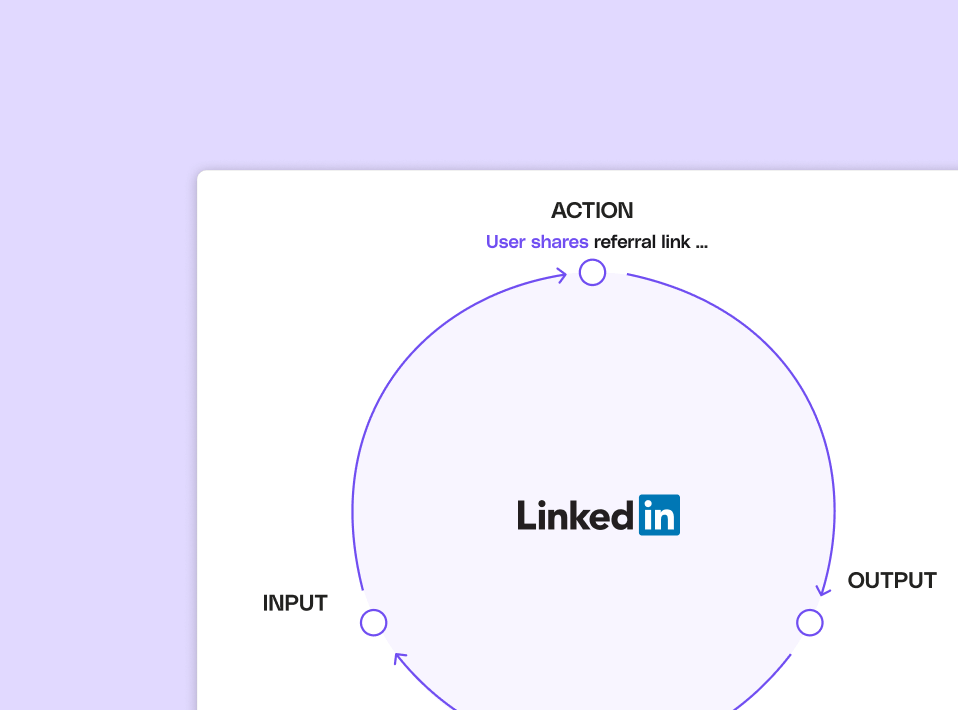
Referral Fees: A Comprehensive Guide
Learn how to boost your sales with powerful referral fee strategies. Discover proven tactics to ...
